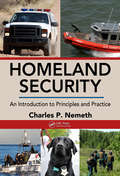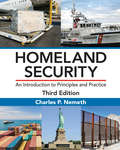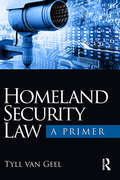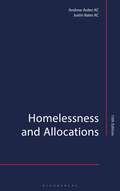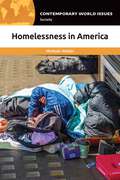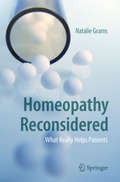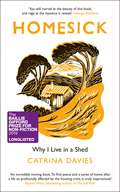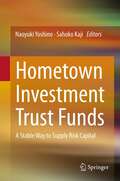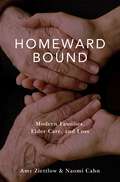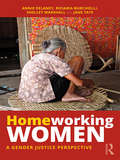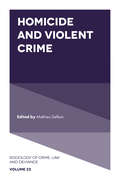- Table View
- List View
Homeland Security: An Introduction to Principles and Practice
by Charles P. NemethSince its formation in 2002�the largest government reorganization since FDR�s "New Deal"�the Department of Homeland Security (DHS) has focused on a broad range of public policy, safety, and security issues. From responsible intelligence gathering and combating global terrorism to securing critical infrastructure and disaster planning and response,
Homeland Security: An Introduction to Principles and Practice, Third Edition
by Charles P. NemethSince formed in 2002, DHS has been at the forefront of determining and furthering some of the most hotly debated security issues facing the U.S. and global community in the 21st century. Nearly 200 university programs with undergrad and graduate majors have cropped up in the last dozen-plus years with limited resources available to teach from. Homeland Security, Third Edition will continue to serve as the core textbook covering the fundamental history, formation, oversight, and reach of DHS currently. The book is fully updated with new laws, regulations and strategies across intelligence, transportation sectors, emergency management, border security, public utilities and public health.
Homeland Security and Private Sector Business: Corporations' Role in Critical Infrastructure Protection, Second Edition
by Chi-Jen Lee Cheng-Hsiung Lu Lucia H. LeeSince 9/11, the U.S. government and the private sector have devised sophisticated ways of protecting people and assets. The threats have evolved, however, becoming more insidious. They no longer comprise just terrorists who target critical infrastructures. They also include insider threats, such as PFC Manning and NSA contractor Snowden who leaked
Homeland Security, its Law and its State: A Design of Power for the 21st Century (Routledge Research in Terrorism and the Law)
by Christos BoukalasThis book assesses the impact of post-9/11 domestic counterterrorism policy on US political life. It examines political discourse, law, institutional architecture, and state-population relations, and shows that ‘homeland security’ is a project with wide-ranging implications for democratic institutions and culture. These implications are addressed through a novel approach that treats law and the state as social relations, and relates developments in law to those in the state and in social dynamics. On this basis, the book examines the new political representations in counterterrorism discourse, especially regarding the relation between the state and the population. It examines the form and content of counterterrorism law, the powers it provides, and the structure and functions it prescribes for the state. By focusing on the new Department of Homeland Security and the restructuring of the intelligence apparatus, the book assesses the new, intelligence-led, policing model. Finally, it examines forms of popular support and resistance to homeland security, to discuss citizenship and state-population relations. The author concludes that homeland security has turned the US into a hybrid polity; the legal and political institutions of democracy remain intact, but their content and practices become authoritarian and exclude the population from politics. These legal and political forms remain operative beyond counterterrorism, in the context of the present economic crisis. They are a permanent configuration of power. This book is an indispensable companion for students of (counter-) Terrorism and Security Studies, Politics, Human Rights, Constitutional and Criminal Law, American Studies, and Criminology.
Homeland Security, its Law and its State: A Design of Power for the 21st Century (Routledge Research in Terrorism and the Law)
by Christos BoukalasThis book assesses the impact of post-9/11 domestic counterterrorism policy on US political life. It examines political discourse, law, institutional architecture, and state-population relations, and shows that ‘homeland security’ is a project with wide-ranging implications for democratic institutions and culture. These implications are addressed through a novel approach that treats law and the state as social relations, and relates developments in law to those in the state and in social dynamics. On this basis, the book examines the new political representations in counterterrorism discourse, especially regarding the relation between the state and the population. It examines the form and content of counterterrorism law, the powers it provides, and the structure and functions it prescribes for the state. By focusing on the new Department of Homeland Security and the restructuring of the intelligence apparatus, the book assesses the new, intelligence-led, policing model. Finally, it examines forms of popular support and resistance to homeland security, to discuss citizenship and state-population relations. The author concludes that homeland security has turned the US into a hybrid polity; the legal and political institutions of democracy remain intact, but their content and practices become authoritarian and exclude the population from politics. These legal and political forms remain operative beyond counterterrorism, in the context of the present economic crisis. They are a permanent configuration of power. This book is an indispensable companion for students of (counter-) Terrorism and Security Studies, Politics, Human Rights, Constitutional and Criminal Law, American Studies, and Criminology.
Homeland Security Law: A Primer
by Tyll van GeelSince 2001 the U.S. government has been engaged in the delicate balancing act of seeking to protect the country against terrorism, both foreign-connected and wholly domestic, while taking into account a number of constitutional protections that can all too easily be trammelled in the effort to assure domestic security. At the same time the development of these policies has created significant constitutional tension among the three branches of the federal government, especially when the President vigorously asserts claims of sweeping power as commander-in-chief in such a way as to raise warnings about the emergence of an imperial presidency. Simultaneously, the rule of law has been placed under stress as the technological prowess of the government has grown. This book addresses these topics in an accessible manner, covering the key developments of domestic security law related to terrorism. Tyll van Geel covers the essential elements of homeland security law including: branches of government and institutions involved in counterterrorism law; border control and immigration; surveillance; the searching of computers and cell phones; the prosecution of terrorists for any number of crimes, including cyberterrorism; military detention; the prosecution of unprivileged enemy belligerents in military commissions; and habeas corpus. The book is designed to offer a clear guide to current issues in domestic security in response to terrorism and will be a valuable guide for concerned citizens as well as undergraduate students studying domestic politics or national security.
Homeland Security Law: A Primer
by Tyll van GeelSince 2001 the U.S. government has been engaged in the delicate balancing act of seeking to protect the country against terrorism, both foreign-connected and wholly domestic, while taking into account a number of constitutional protections that can all too easily be trammelled in the effort to assure domestic security. At the same time the development of these policies has created significant constitutional tension among the three branches of the federal government, especially when the President vigorously asserts claims of sweeping power as commander-in-chief in such a way as to raise warnings about the emergence of an imperial presidency. Simultaneously, the rule of law has been placed under stress as the technological prowess of the government has grown. This book addresses these topics in an accessible manner, covering the key developments of domestic security law related to terrorism. Tyll van Geel covers the essential elements of homeland security law including: branches of government and institutions involved in counterterrorism law; border control and immigration; surveillance; the searching of computers and cell phones; the prosecution of terrorists for any number of crimes, including cyberterrorism; military detention; the prosecution of unprivileged enemy belligerents in military commissions; and habeas corpus. The book is designed to offer a clear guide to current issues in domestic security in response to terrorism and will be a valuable guide for concerned citizens as well as undergraduate students studying domestic politics or national security.
Homelessness And Allocations: A Guide To The Housing Act 1996 Parts 6 And 7 And The Housing (wales) Act 2014 Part 2
by Andrew Arden Justin BatesA definitive guide to protecting the rights of the homeless, this text clearly sets the law in its context and appendices reproduce the relevant consolidated legislation and guidance.
Homelessness and Allocations: A Guide to the Housing Act 1996 Parts 6 and 7 and the Housing (Wales) Act 2014 Part 2 (Eleventh Edition)
by Andrew Arden Justin Bates Toby Vanhegan Legal StaffHomelessness and Allocations, now in its eleventh edition, has established itself as the definitive guide to the rights of the homeless. Written by leading experts, the text clearly and succinctly sets the law in its context, and appendices reproduce the relevant consolidated legislation and guidance.
Homelessness and Allocations
by Andrew Arden KC Justin Bates KC"This is the book on the law relating to homelessness." The Law Society Gazette*"An indispensable commentary on and guide to a complex and fast-moving area of the law: a must-have for academics, specialist practitioners and busy local government officers alike." Solicitors Journal*For over 40 years, Homelessness and Allocations has been providing advice on the rights of the homeless and the duties of local government. The 13th edition includes updates on: - More than 50 new cases – including R (Imam) v Croydon LBC; R (Jaberi) v Westminster CC; Zaman v Waltham Forest LBC; Uduezue v Bexley LBC; and R (Campbell) v Ealing LBC- The homelessness provisions of the Renters (Reform) Bill 2023-24- Amendments to the Housing Act 1996, Pts 6 and 7, including by the Supported Housing (Regulatory Oversight) Act 2023- Welsh statutory changes Written by two leading experts in the field, this text is the definitive guide on homelessness for housing lawyers and advisers, local authorities, housing and homelessness officers and housing associations.This title is included in Bloomsbury Professional's Property and Land Law online service.*Review of a previous edition.
Homelessness in America: A Reference Handbook (Contemporary World Issues)
by Michele WakinThis title provides a one-stop resource for understanding the crisis of homelessness in the United States. It covers risk factors for homelessness, societal attitudes about the homeless, and public and private resources designed to prevent homelessness and help those in need.There are a number of questions to be answered when addressing the subject of homelessness in the United States. What are the primary causes of homelessness? What are the economic and socioeconomic factors that have an impact on homeless people? What demographic trends can be identified in homeless populations? Is the U.S. addressing the needs and concerns of homeless people adequately? Where are the areas with the highest homeless populations? What can be done to help homeless people who live with mental illness and/or addiction problems?Homelessness in America: A Reference Handbook answers all of these questions and more. It thoroughly examines the history of homelessness in the U.S., shining a light on the key issues, events, policies, and attitudes that contribute to homelessness and shape the experience of being homeless. It places special emphasis on exploring the myriad problems that force people into homelessness, such as inadequate levels of affordable housing, struggles with substance abuse, and gaps in the U.S.' social welfare system. In addition, it explains why some demographic groups are at heightened risk of homelessness.
Homelessness in America: A Reference Handbook (Contemporary World Issues)
by Michele WakinThis title provides a one-stop resource for understanding the crisis of homelessness in the United States. It covers risk factors for homelessness, societal attitudes about the homeless, and public and private resources designed to prevent homelessness and help those in need.There are a number of questions to be answered when addressing the subject of homelessness in the United States. What are the primary causes of homelessness? What are the economic and socioeconomic factors that have an impact on homeless people? What demographic trends can be identified in homeless populations? Is the U.S. addressing the needs and concerns of homeless people adequately? Where are the areas with the highest homeless populations? What can be done to help homeless people who live with mental illness and/or addiction problems?Homelessness in America: A Reference Handbook answers all of these questions and more. It thoroughly examines the history of homelessness in the U.S., shining a light on the key issues, events, policies, and attitudes that contribute to homelessness and shape the experience of being homeless. It places special emphasis on exploring the myriad problems that force people into homelessness, such as inadequate levels of affordable housing, struggles with substance abuse, and gaps in the U.S.' social welfare system. In addition, it explains why some demographic groups are at heightened risk of homelessness.
Homeopathy Reconsidered: What Really Helps Patients
by Natalie GramsHomeopathy is over 200 years old and is still experiencing an uninterrupted influx of new practitioners and patients. Many patients and therapists swear by this "alternative healing method", which in some countries is even financed by health insurances. This seems completely incomprehensible to critics: For them it is clearly evident that homeopathy is hopelessly unscientific and has at best a placebo effect. The positions of supporters and opponents seem to be just as immutable as they are incompatible. This book answers some essential and fascinating questions: What remains of the founding ideas of homeopathy in 21st century medicine? Does it really work and, if so, how? Which of the original theories can we still apply today with a clear conscience and use for the benefit of patients and the healthcare system? Where does homeopathy have its limits and does it indeed need to be critically reconsidered and evaluated? The author has dealt with the points of criticism for years, but at the same time also takes seriously the wishes and concerns of patients who often feel insufficiently cared for by conventional medical practice. Against the background of her own personal history, her book attempts to bridge the gap between these two traditionally opposing camps.
Homesick: Why I Live in a Shed
by Catrina DaviesThe story of a personal housing crisis that led to a discovery of the true value of home.*'You will marvel at the beauty of this book, and rage at the injustice it reveals' George Monbiot**'Incredibly moving. To find peace and a sense of home after a life so profoundly affected by the housing crisis, is truly inspirational' Raynor Winn, bestselling author of The Salt Path*Aged thirty-one, Catrina Davies was renting a box-room in a house in Bristol, which she shared with four other adults and a child. Working several jobs and never knowing if she could make the rent, she felt like she was breaking apart. Homesick for the landscape of her childhood, in the far west of Cornwall, Catrina decides to give up the box-room and face her demons. As a child, she saw her family and their security torn apart; now, she resolves to make a tiny, dilapidated shed a home of her own.With the freedom to write, surf and make music, Catrina rebuilds the shed and, piece by piece, her own sense of self. On the border of civilisation and wilderness, between the woods and the sea, she discovers the true value of home, while trying to find her place in a fragile natural world.This is the story of a personal housing crisis and a country-wide one, grappling with class, economics, mental health and nature. It shows how housing can trap us or set us free, and what it means to feel at home.
Hometown Investment Trust Funds: A Stable Way to Supply Risk Capital
by Naoyuki Yoshino and Sahoko KajiThis book records the first success stories of a new form of financial intermediation, the hometown investment fund, that has become a national strategy in Japan, partly to meet the need to finance small and medium-sized enterprises (SMEs) after the devastating earthquake and tsunami in March 2011.The hometown investment fund has three main advantages. First, it contributes to financial market stability by lowering information asymmetry. Individual households and firms have direct access to information about the borrowing firms, mainly SMEs, that they lend to. Second, it is a stable source of risk capital. The fund is project driven. Firms and households decide to invest by getting to know the borrowers and their projects. In this way the fund distributes risk but not so that it renders risk intractable, which was the problem with the “originate and distribute” model. Third, it contributes to economic recovery by connecting firms and households with SMEs that are worthy of their support. It also creates employment opportunities, at the SMEs as well as for the pool of retirees from financial institutions who can help assess the projects.Introduction of the hometown investment fund has huge global implications. The world is seeking a method of financial intermediation that minimizes information asymmetry, distributes risk without making it opaque, and contributes to economic recovery. Funds similar to Japan’s hometown investment fund can succeed in all three ways. After all, the majority of the world’s businesses are SMEs. The first chapter explains the theory behind this method, and the following chapters relate success stories from Japan and other parts of Asia. This book should encourage policymakers, economists, lenders, and borrowers, especially in developing countries, to adopt this new form of financial intermediation, thus contributing to global economic stability.
The Homevoter Hypothesis: How Home Values Influence Local Government Taxation, School Finance, and Land-Use Policies
by William A. FischelJust as investors want the companies they hold equity in to do well, homeowners have a financial interest in the success of their communities. If neighborhood schools are good, if property taxes and crime rates are low, then the value of the homeowner’s principal asset—his home—will rise. Thus, as William Fischel shows, homeowners become watchful citizens of local government, not merely to improve their quality of life, but also to counteract the risk to their largest asset, a risk that cannot be diversified. Meanwhile, their vigilance promotes a municipal governance that provides services more efficiently than do the state or national government. Fischel has coined the portmanteau word “homevoter” to crystallize the connection between homeownership and political involvement. The link neatly explains several vexing puzzles, such as why displacement of local taxation by state funds reduces school quality and why local governments are more likely to be efficient providers of environmental amenities. The Homevoter Hypothesis thereby makes a strong case for decentralization of the fiscal and regulatory functions of government.
Homeward Bound: Modern Families, Elder Care, and Loss
by Naomi Cahn Amy ZiettlowHomeward Bound shows that as family structure becomes more complex, so too does elder care, and existing institutions and legal approaches are not prepared to handle those complexities. As 79 million American Baby Boomers approach old age, their diverse family structures mean the burden of care will fall on a different cast of family members than in the past. Our current approaches are based on an outdated caregiving model that presumes life-long connection between the parents and offspring, with the existence of high internal norm cohesion among family members providing a valuable safety net for caregiving. Single parent and remarried parent-led families are far more complicated, fragile, and point to the need for increased formal support from the religious, medical, legal, and public policy communities. We base our analysis on in-depth, qualitative interviews with surviving grown children and stepchildren whose mother, father, stepparent, or ex-stepparent died. Their stories illustrate the profound ways that the caregiving, mourning, and inheritance process has changed in ways not adequately reflected in formal legal, medical, and religious tools. The solutions center on awareness and preparation: providing more support for individual planning for incapacity and death and, even more importantly, creating legal, political, and social planning for the "graying of America" at a time of increasingly complex familial ties.
Homeward Bound: Modern Families, Elder Care, and Loss
by Amy Ziettlow Naomi CahnHomeward Bound shows that as family structure becomes more complex, so too does elder care, and existing institutions and legal approaches are not prepared to handle those complexities. As 79 million American Baby Boomers approach old age, their diverse family structures mean the burden of care will fall on a different cast of family members than in the past. Our current approaches are based on an outdated caregiving model that presumes life-long connection between the parents and offspring, with the existence of high internal norm cohesion among family members providing a valuable safety net for caregiving. Single parent and remarried parent-led families are far more complicated, fragile, and point to the need for increased formal support from the religious, medical, legal, and public policy communities. We base our analysis on in-depth, qualitative interviews with surviving grown children and stepchildren whose mother, father, stepparent, or ex-stepparent died. Their stories illustrate the profound ways that the caregiving, mourning, and inheritance process has changed in ways not adequately reflected in formal legal, medical, and religious tools. The solutions center on awareness and preparation: providing more support for individual planning for incapacity and death and, even more importantly, creating legal, political, and social planning for the "graying of America" at a time of increasingly complex familial ties.
Homeworking Women: A Gender Justice Perspective
by Annie Delaney Rosaria Burchielli Shelley Marshall Jane TateHomework; work that is categorised as informal employment, performed in the home, mainly for subcontractors and mostly undertaken by women. The inequities and injustices inherent in homework conditions maintain women’s weak bargaining position, preventing them from making any improvements to their lives via their work. The best way to tackle these issues is not to abolish, but to bring equality and justice to homework. This book contributes a gender justice framework to analyse and confront the issues and problems of homework. The authors propose four justice dimensions – recognition, representation, rights and redistribution – to examine and analyse homework. This framework also takes into account the structures and processes of capitalism and the patriarchy, and the relations of domination that are widely held to be the major factors that determine homework injustice. The authors discuss strategies and approaches that have worked for homeworkers, highlighting why they worked and the features that were beneficial for them. Homeworking Women will be of interest to individuals and organisations working with or for the collective benefit of homeworkers, academics and students interested in feminism, labour regulation, informal work, supply chains and social and political justice.
Homeworking Women: A Gender Justice Perspective
by Annie Delaney Rosaria Burchielli Shelley Marshall Jane TateHomework; work that is categorised as informal employment, performed in the home, mainly for subcontractors and mostly undertaken by women. The inequities and injustices inherent in homework conditions maintain women’s weak bargaining position, preventing them from making any improvements to their lives via their work. The best way to tackle these issues is not to abolish, but to bring equality and justice to homework. This book contributes a gender justice framework to analyse and confront the issues and problems of homework. The authors propose four justice dimensions – recognition, representation, rights and redistribution – to examine and analyse homework. This framework also takes into account the structures and processes of capitalism and the patriarchy, and the relations of domination that are widely held to be the major factors that determine homework injustice. The authors discuss strategies and approaches that have worked for homeworkers, highlighting why they worked and the features that were beneficial for them. Homeworking Women will be of interest to individuals and organisations working with or for the collective benefit of homeworkers, academics and students interested in feminism, labour regulation, informal work, supply chains and social and political justice.
Homicide: A Bibliography, Second Edition
by Bal K. Jerath Rajinder JerathHomicide represents the result of an exhaustive search of the world literature regarding homicide. More than 7,000 entries have been compiled from references selected from major indexes in libraries from outstanding universities, government agencies, and military posts; science libraries; law libraries; and the Library of Congress. Each entry features a one- or two-word annotation that indicates whether it is an article or a book, and all entries conform to the American Psychological Association stylebook guidelines. Key-word and author indexes provide quick access to works pertaining to particular subjects or by a certain author.
Homicide: A Bibliography, Second Edition
by Bal K. Jerath Rajinder JerathHomicide represents the result of an exhaustive search of the world literature regarding homicide. More than 7,000 entries have been compiled from references selected from major indexes in libraries from outstanding universities, government agencies, and military posts; science libraries; law libraries; and the Library of Congress. Each entry features a one- or two-word annotation that indicates whether it is an article or a book, and all entries conform to the American Psychological Association stylebook guidelines. Key-word and author indexes provide quick access to works pertaining to particular subjects or by a certain author.
Homicide: A Forensic Psychology Casebook
by Joan Swart and Lee MellorForensic psychology plays an increasingly important role in criminal investigations and legal decision-making. Homicide: A Forensic Psychology Casebook guides readers through the practical aspects of homicide cases across the entire criminal justice system, from the investigative process to the criminal trial process, and beyond. Each chapter contains a description and analysis of selected cases and offenders, and provides a crime narrative and offender narrative to illustrate the underlying theory and practical considerations of homicide investigations. Criminal justice students and practitioners alike will benefit from the comprehensive scope of this text. In order to ensure fair and efficient criminal justice practices in the field of forensic investigation, there is still a need for conformity and standardization of sound protocols and approaches based on improved knowledge and education. This book is part of that effort to understand homicidal behavior and offenders better in order to prevent similar crimes.
Homicide: A Forensic Psychology Casebook
by Joan Swart Lee MellorForensic psychology plays an increasingly important role in criminal investigations and legal decision-making. Homicide: A Forensic Psychology Casebook guides readers through the practical aspects of homicide cases across the entire criminal justice system, from the investigative process to the criminal trial process, and beyond. Each chapter contains a description and analysis of selected cases and offenders, and provides a crime narrative and offender narrative to illustrate the underlying theory and practical considerations of homicide investigations. Criminal justice students and practitioners alike will benefit from the comprehensive scope of this text. In order to ensure fair and efficient criminal justice practices in the field of forensic investigation, there is still a need for conformity and standardization of sound protocols and approaches based on improved knowledge and education. This book is part of that effort to understand homicidal behavior and offenders better in order to prevent similar crimes.
Homicide and Violent Crime (Sociology of Crime, Law and Deviance #23)
by Mathieu DeflemThis volume of Sociology of Crime, Law and Deviance addresses a variety of issues and concerns involved with the study of violent crime and homicide in the contemporary world. The chapters are conceived against the background of the enduring nature of violence and killing in the modern age, despite trends towards increased levels of civilization and the protection of rights. Whilst it is clear that the world of today is, in many respects, a better place, violence and homicide remain and even increase from time to time and from place to place. Each chapter tackles key questions of how and why these problematic forms of behaviour continue to exist. Specifically, chapters examine the killing of children, responses to domestic abuse, female killers, incidents of racial and religious violence, the dynamics of violence on college campuses, the role of police and state institutions in relation to violence, and global aspects of violence and murder. This book will be of interest to scholars and students in criminology, sociology, criminal justice, and public policy.
